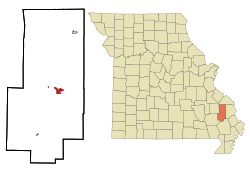2010 census
As of the census [11] of 2010, there were 1,477 people, 604 households, and 369 families residing in the city. The population density was 900.6 inhabitants per square mile (347.7/km2). There were 705 housing units at an average density of 429.9 per square mile (166.0/km2). The racial makeup of the city was 96.41% White, 1.02% Native American, 0.81% Asian, 0.34% from other races, and 1.42% from two or more races. Hispanic or Latino of any race were 1.76% of the population.
There were 604 households, of which 30.8% had children under the age of 18 living with them, 41.2% were married couples living together, 15.9% had a female householder with no husband present, 4.0% had a male householder with no wife present, and 38.9% were non-families. 33.6% of all households were made up of individuals, and 16% had someone living alone who was 65 years of age or older. The average household size was 2.32 and the average family size was 2.93.
The median age in the city was 39.8 years. 24.8% of residents were under the age of 18; 8.9% were between the ages of 18 and 24; 20.5% were from 25 to 44; 24.7% were from 45 to 64; and 20.9% were 65 years of age or older. The gender makeup of the city was 43.4% male and 56.6% female.
2000 census
As of the census [3] of 2000, there were 1,502 people, 642 households, and 414 families residing in the city. The population density was 935.9 inhabitants per square mile (361.4/km2). There were 719 housing units at an average density of 448.0 per square mile (173.0/km2). The racial makeup of the city was 95.67% White, 0.13% African American, 1.40% Native American, 0.80% Asian, 0.13% from other races, and 1.86% from two or more races. Hispanic or Latino of any race were 0.80% of the population. Among the major first ancestries reported in Marble Hill are 16.2% German, 14.5% English, 14.4% Irish, 11.4% American, 5.4% Dutch, and 3.4% French.
There were 642 households, out of which 31.8% had children under the age of 18 living with them, 46.6% were married couples living together, 15.6% had a female householder with no husband present, and 35.5% were non-families. 32.6% of all households were made up of individuals, and 17.0% had someone living alone who was 65 years of age or older. The average household size was 2.31 and the average family size was 2.93.
In the city the population was spread out, with 27.2% under the age of 18, 9.1% from 18 to 24, 24.8% from 25 to 44, 20.0% from 45 to 64, and 18.9% who were 65 years of age or older. The median age was 36 years. For every 100 females, there were 83.4 males. For every 100 females age 18 and over, there were 78.8 males.
The median income for a household in the city was $22,163, and the median income for a family was $29,871. Males had a median income of $25,093 versus $16,161 for females. The per capita income for the city was $12,857. About 17.4% of families and 19.6% of the population were below the poverty line, including 24.4% of those under age 18 and 22.1% of those age 65 or over.


